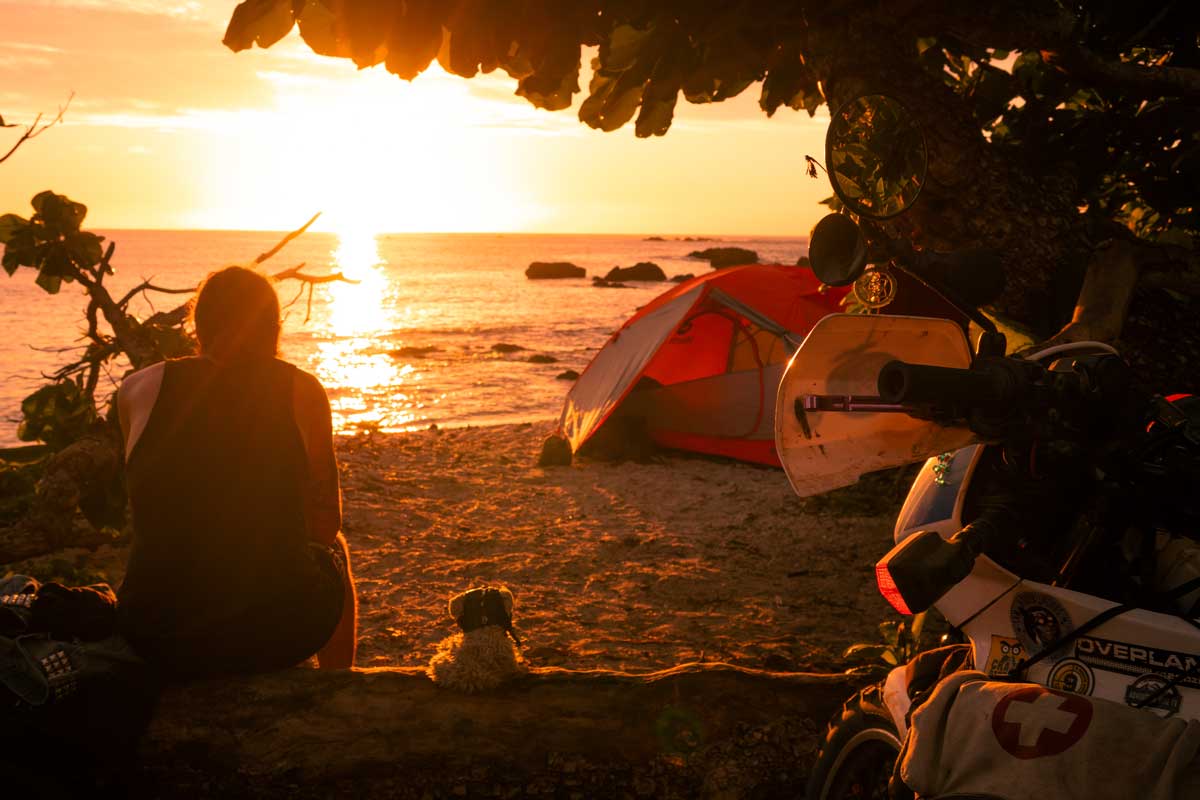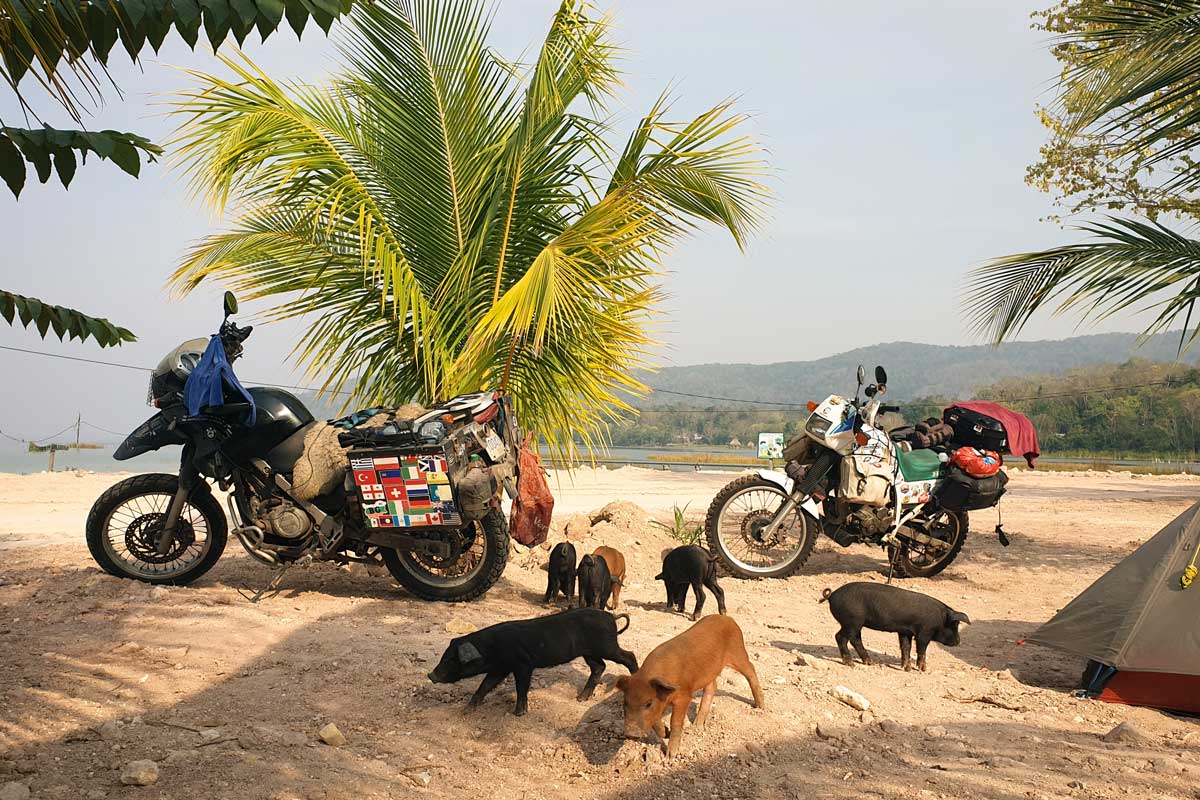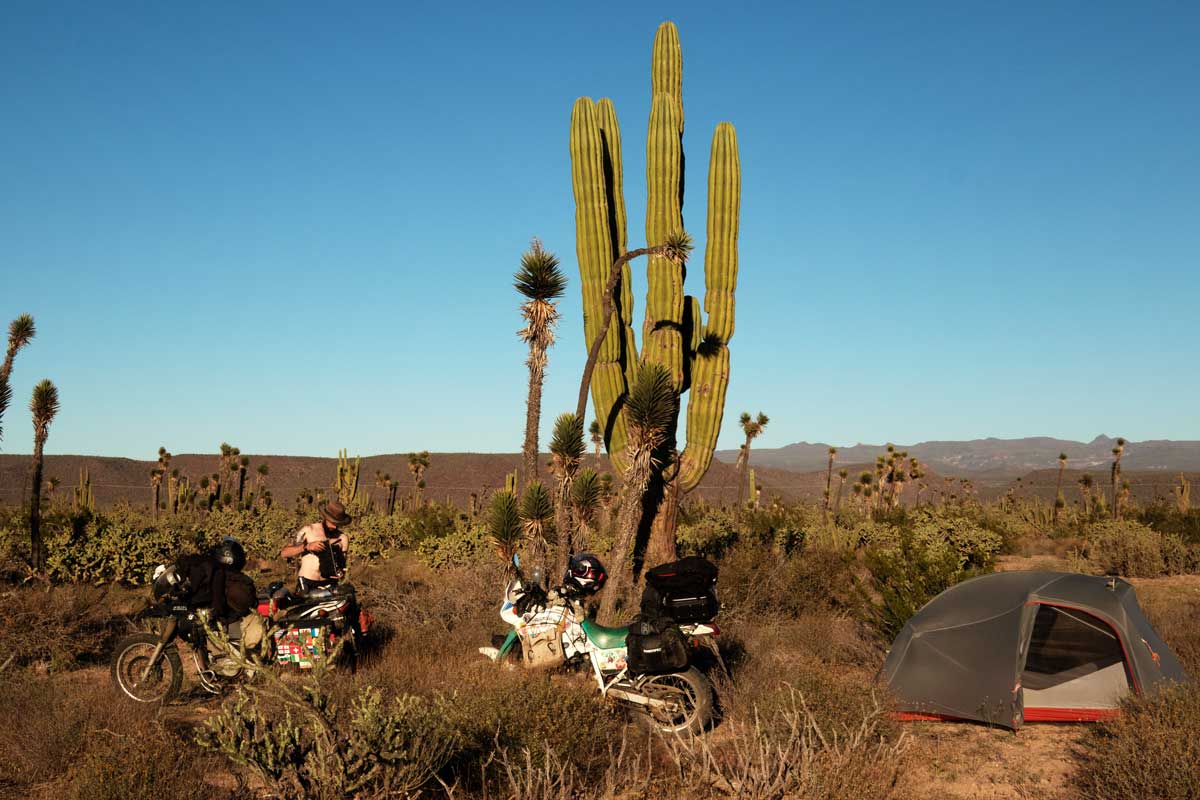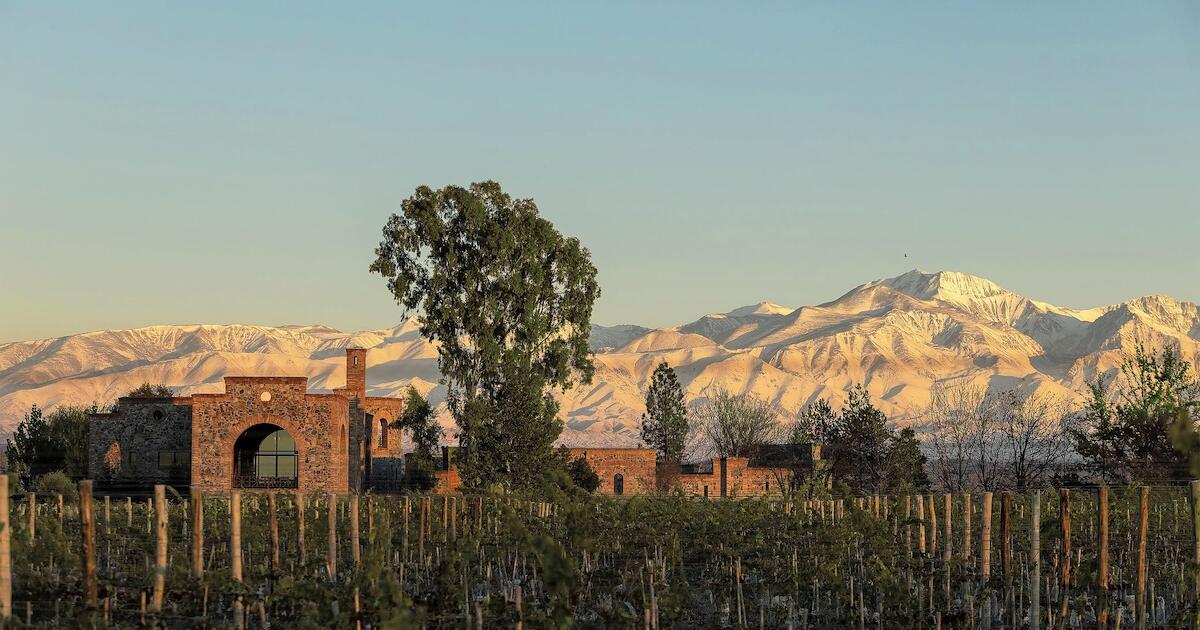How to Stay Safe While Camping in the Wild

Written by and Photos by Maria Schumacher. Posted in Tech-n-Tips
For me, choosing whether to wild camp or stay at an official campsite depends on what’s available and what I need for the night. After a few days in the middle of nowhere, the promise of proper toilets, showers, maybe even laundry facilities, electricity, and wi-fi will make a paid campsite very appealing. It might even be possible to safely leave the bike and gear there while exploring town or on a hike. But then there’s a higher chance of noisy, inconsiderate neighbors.
So, before I know it, I’m craving the freedom of beautifully wild nature and stunning vistas, far from anyone else. Out there, you must take care of our own safety. But it’s free, and I have yet to find a hotel that beats camping under the stars in the desert or listening to the waves lap at the beach in the silver moonlight.
With that in mind, here are a few pointers on wild camping that my riding partner Aidan and I have learned over the years while exploring the world on our motorcycles.

• Looking for Your Spot
It’s best to start looking for a camping spot a few hours before dark since the first one or two might not work out. If we get lucky, this gives us time for bike maintenance and cooking a relaxing meal. Extra time also allows us to get a feel for the place and chat with any locals whom we happen upon. Most we meet welcome our camping, are curious about our travels, and like to share local knowledge.
When our Spanish wasn’t good enough to understand a farmer in Mexico, he resorted to “baaing” and barking noises. It turned out that early the next morning, we awoke to the sound of many tiny hooves pattering along the hard ground, accompanied by the predicted barking. We had pitched on a well-used shepherding route.
Where free places are harder to find, we have a “Plan B”—like a town with hotels within reach before dark. We also use Wikicamps and the iOverlander apps, where others have marked camping spots they found.
• Hidden Spots vs. Camping in the Open
Some feel safer camping where everyone knows they’re there, so a potential opportunist may not target them for fear of being discovered by the locals or police. We tend towards the hidden option, relying on not being found by anyone at all. In our experience, those who rob tourists operate in more popular places. At the same time, camping is so unheard of in remote areas that anyone who finds you is usually nothing more than highly curious. They’re often welcoming and might even share food or drinks.
Sometimes it helps to ask for permission. In the hazelnut- and tea-growing mountains of northeastern Turkey, we couldn’t find anywhere flat enough to pitch a tent. In the end, we asked permission at a small house. They phoned the local imam to obtain permission to let us pitch our tent on the flat roof of their neighbor’s unfinished house. And, of course, we were invited into their home for a yummy dinner of tea and homemade sweets.
 Wild camping on a high mountain pass in Colombia.
Wild camping on a high mountain pass in Colombia.
• Avoiding Animals
Food and rubbish attract scavengers like possums and rats, so we stow this stuff in a metal pannier. In bear country, we hang our food and smelly cosmetics like toothpaste in a tree far from the tent. They might still be able to reach it, but at least they don’t be tearing through our tent to get at it. Also, it only took a few fiery bites from hundreds of ants to teach us to closely inspect the ground before pitching the tent.
Domestic animals need to be considered, too. Near Istanbul, we camped in an empty grass field and awoke surrounded by dogs barking and howling. We tried to stay quiet and ignore them until they left, but it didn’t work. We finally gave in, braced ourselves for the imminent attack, and opened the tent—only to find a pack of cute little puppies hoping to share our breakfast salami.
 In many countries, domestic animals are allowed to roam freely and might get curious about your things.
In many countries, domestic animals are allowed to roam freely and might get curious about your things.
• Tent Considerations
Even the thickest ground sheet is no match for cacti and thorns, but a quick sweeping with my big bike boots usually does the trick. As much as we love the shade of trees, we always check for things like dead branches, coconuts, and pinecones that might drop in a storm. If you’re camping by a river or lake, try to get information from locals on tide tables or whether the water line is likely to change—being downriver from a snow melt or a hydroelectric dam can spell trouble. If you can’t find anyone, washed-up debris usually indicates the high tide line.
Wind can blow sand into the tent. It may not be windy when you’re setting up, but that can change in the middle of the night, so it’s a good idea always to take the extra effort to peg the tent properly. In sandy soil, weigh the pegs down with rocks. That lesson was hard learned at an idyllic lakeside camping spot in Nicaragua with a view of Volcan Concepcion, where I’d tied one side of the rain tarp to my bike. At sunrise the tarp began flapping wildly in a sudden torrential rainstorm. It pulled the bike over, so there we were in T-shirts and underwear, drenched in seconds, digging out the bike and wrestling with the flapping tarp.
And sometimes it’s we who pose the danger. When beach camping, take extra care to avoid riding and pitching on stretches where sea turtles may have laid their eggs in the sand. That goes wherever you’re camping; make sure you’re not impacting wildlife somehow.
 Wild camping among the giant cacti in the deserts of Baja California.
Wild camping among the giant cacti in the deserts of Baja California.
• Campfires
If you want the ambiance of a campfire, make sure to check if there’s a fire ban in place. In California, for example, you need a fire permit, even for campsites. And then there are the basics: clear any flammable debris within a generous vicinity of the firepit, build a containing wall of stones or sand, take care that there are no vulnerable branches above, and put the fire completely out when you’re finished. If water is scarce, sand does the trick to suffocate it.
Make sure your tent isn’t downwind from the fire, as glowing sparks can burn holes into it or even set it alight.
You don’t need a big fire for cooking. In fact, I love the method I first saw in India, where you stand the pot on three stones (or empty drink cans) and feed branches into the glowing embers in between. We also love to toast tortillas or bake bread on a clean rock heated up in the middle of the fire. Once the flames die down, the embers bake the small flatbreads. But be aware that some rocks contain trapped water that can expand in the heat and explode!
 Heating tortillas on a clean stone in the cooking fire.
Heating tortillas on a clean stone in the cooking fire.
• Using Nature’s Bathroom
Some of my friends find it unthinkable to go to the loo out in the forest, but I have come to prefer it to smelly gas station toilets. The trick is not to leave a great big mess for others or wildlife to stumble upon, so find a place well out of the way of busy paths and popular recreational areas. Some burn their toilet paper, but bearing wildfires in mind, I simply bury everything six inches deep.
• Clean Campsite Mechanics
Working on the bike in the evening is unavoidable—from tightening loose nuts and bolts after a rattly offroad day, to checking the tire pressure and oil level on a regular basis. We do much of the maintenance ourselves, so this extends to tire changes, replacing chains and sprockets and the like—not to mention any breakdown repairs on the road.
Avoiding pollution is paramount, so we’ve gotten really good at “clean mechanics.” It’s a bit like cooking, where preparation is half the work. For oil and coolant changes, we spread garbage bags under the bike. We also installed a handy valve in the sump where you clip in the opener, which is attached to a hose so you can fill the oil straight into an empty bottle without the need for a catch basin.
For any general mechanicking, our tarp doubles up as a clean sheet to place tools and bike parts. Our tool roll lids serve as containers to keep bolts and nuts from disappearing into the grass. We push a toilet paper roll onto the front brake lever, which is handy for wiping things, and all rubbish goes straight into a garbage bag hung on the bike’s front indicator.
 The hands might be oily, so long as the grass stays clean; changing the drive chain at a campsite in Australia.
The hands might be oily, so long as the grass stays clean; changing the drive chain at a campsite in Australia.
• Wild Camping Etiquette
This one is probably common sense to most motor travelers. “Leave nothing but footprints behind” is such a cliche, but that doesn’t make it any less true. How often do we arrive at a campsite only to find small pieces of tent string or plastic clips and beer caps? To miss something is only human, so I pick up trash everywhere we go.
It’s also the impression we make on behalf of all motorcycle campers. If we were to upset the locals by breaking the rules or being unkind, they wouldn’t be so welcoming to the next motorcycle traveler they met.
• Knowing When to Move On
Sometimes our traveler’s sixth sense tells us something’s not right, other times it just becomes obvious because the locals—or even the police—tell us it’s not safe to stay. It can be frustrating, especially after we’ve set up everything, so I try to remind myself that it often comes from concern for our safety.
A friendly encounter can sometimes grow out of hand. Once in India, we turned down one dirt road after the next, finally pitching the tent when we were sure there was no one far and wide in the stony Rajasthani desert. Soon, two men materialized, asking us if we needed water. We politely declined, and they left us to it. Minutes later, they were back with five more friends in tow. What about snakes? After inspecting our tent inside and out, we had them convinced that the zippers would shut out any critters.
Just as we were considering cooking dinner, the crowd was back, this time including women and children, all curious to see what we were up to. They began inspecting the bikes, asking endless questions like, “How much, sir?” “Sir, where from, sir?” as more and more appeared out of the dark night. The police eventually showed up and insisted we pack up and follow them to a hotel.
After several years of travel, I can count the times on one hand when we had to move, like in this instance. Listen to your instincts. You may never know if they’re right, but in the worst case, you pay for a stuffy one-off hotel, knowing you’ll soon be back out there sharing another starry night under the stars.
 Curious people in Rajasthan, India, wanting to know all about our trip, our tent, and our motorcycles.
Curious people in Rajasthan, India, wanting to know all about our trip, our tent, and our motorcycles.
 Inspired at a book signing during a motorcycle show in London, Maria Schumacher and her partner Aidan decided to ride around the world by motorbike, even though they had never sat on motorcycles before. Since then, they have led a life interrupted by travel across Europe, Turkey, Georgia, India, and Australia. They started their journey on a pair of BMW F650GSes, but while Aidan still rides his, Maria switched to a Honda NX250. They have lived in Vancouver for the last few years and are now on their way to Argentina.
Inspired at a book signing during a motorcycle show in London, Maria Schumacher and her partner Aidan decided to ride around the world by motorbike, even though they had never sat on motorcycles before. Since then, they have led a life interrupted by travel across Europe, Turkey, Georgia, India, and Australia. They started their journey on a pair of BMW F650GSes, but while Aidan still rides his, Maria switched to a Honda NX250. They have lived in Vancouver for the last few years and are now on their way to Argentina.
link




:max_bytes(150000):strip_icc()/TAL-header-faro-algarve-portugal-CALIOFEUROPE0825-fa978d40a74a406b95586473636292f1.jpg)

